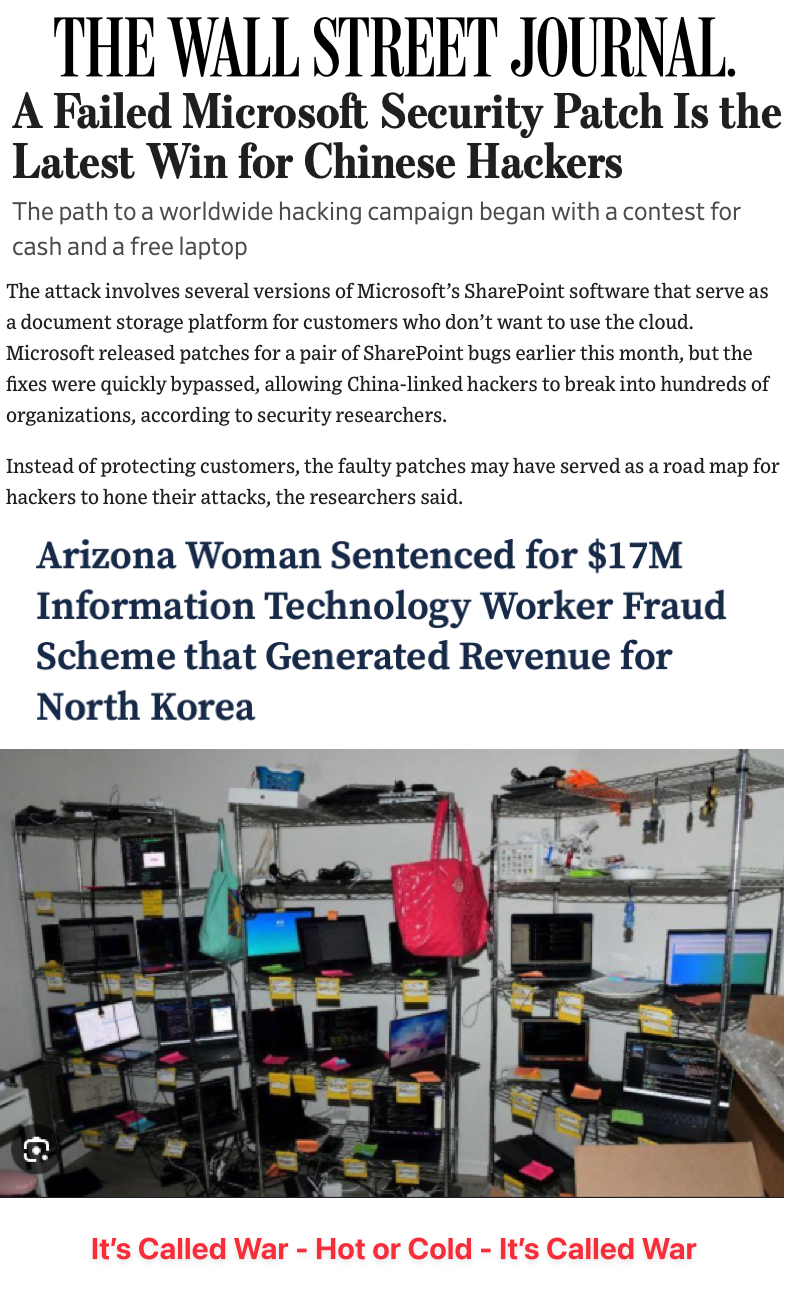It's Called War
And this is the woman W.P. hates?
As the late R.K. said…
Think About It
The primary goal of Paul Truesdell's "Think About It" blog post is to encourage clients and prospective clients to contemplate the ongoing "cold war" being waged by North Korea and China. It aims to provoke thought on these contemporary geopolitical conflicts.
Paul Truesdell's communication style is characterized as intentionally "thought provoking," utilizing "sarcasm and talking in code." He aims for "self enlightenment" in his readers, preferring to "spoon feed information" only when necessary and offering "nudges" to guide them to "aha moments."
The "Think About It" blog post aligns with Truesdell's goals by presenting specific "snowflakes" like the "Microsoft China cyberattacks" reference. These are intended to be "nudges" that prompt readers to connect seemingly disparate events and arrive at their own conclusions about the modern "cold war," consistent with his "self enlightenment" approach.
A specific example of China's involvement in "cyber warfare" is highlighted by the "Failed Microsoft Security Patch" incident. Chinese hackers were able to bypass Microsoft's fixes for SharePoint bugs, subsequently breaking into hundreds of organizations and illustrating sophisticated digital aggression.
North Korea's "cold war" involvement is illustrated through non-traditional means, specifically through a "$17M Information Technology Worker Fraud Scheme." This financial illicit activity generated revenue for North Korea, showcasing how nations can wage conflict through economic and cyber means rather than conventional military confrontation.
The faulty patches released by Microsoft were significant because, instead of protecting customers, they inadvertently served as a "road map for hackers to hone their attacks." This allowed China-linked hackers to quickly bypass the fixes and infiltrate numerous organizations, turning a supposed security measure into an advantage for the attackers.
The potential purpose of including seemingly unrelated content, such as the mention of "Whoopi Goldberg," is an example of Truesdell's "talking in code" and sarcasm. It could serve as a "snowflake" to prompt reflection on internal divisions or societal distractions that might overshadow the more subtle, yet impactful, external "cold war" issues he wants his audience to consider.
Truesdell utilizes the concept of "snowflakes" as individual pieces of information, events, or topics that initially appear unconnected. His method is to link these "snowflakes" together, gradually building them into a "snowball" of interconnected understanding, which he then "rolls down a hill" to help readers achieve "aha moments" through self-enlightenment.
The broader "aha moment" Truesdell aims for his audience to achieve is a comprehensive understanding of the pervasive and multifaceted nature of the modern "cold war" being waged by North Korea and China. He wants them to recognize that this conflict extends beyond conventional warfare into areas like cyberattacks and financial schemes, without him explicitly stating the connections.
Think About It
Think about how Paul Truesdell's communication strategy, as described in the sources, challenges traditional methods of news dissemination and opinion shaping.
Think about the concept of a "cold war" as presented in the provided texts, specifically focusing on how the actions of China and North Korea illustrate this modern form of conflict.
Think about the role of "cyber warfare" as a significant component of the "cold war" described by Truesdell.
Paul Truesdell's style relies on indirect communication and the reader's "self enlightenment."
Think about how this approach is rejected by the broad and general audience of social media versus his specific target audience of "clients and prospective clients.”
Think about how the "snowflakes" presented in the sources (e.g., Microsoft patches, North Korean fraud, Whoopi Goldberg, and Rodney King) and explain how Truesdell intends for a discerning reader to connect these disparate elements into a cohesive "aha moment" regarding the nature of the modern cold war.

